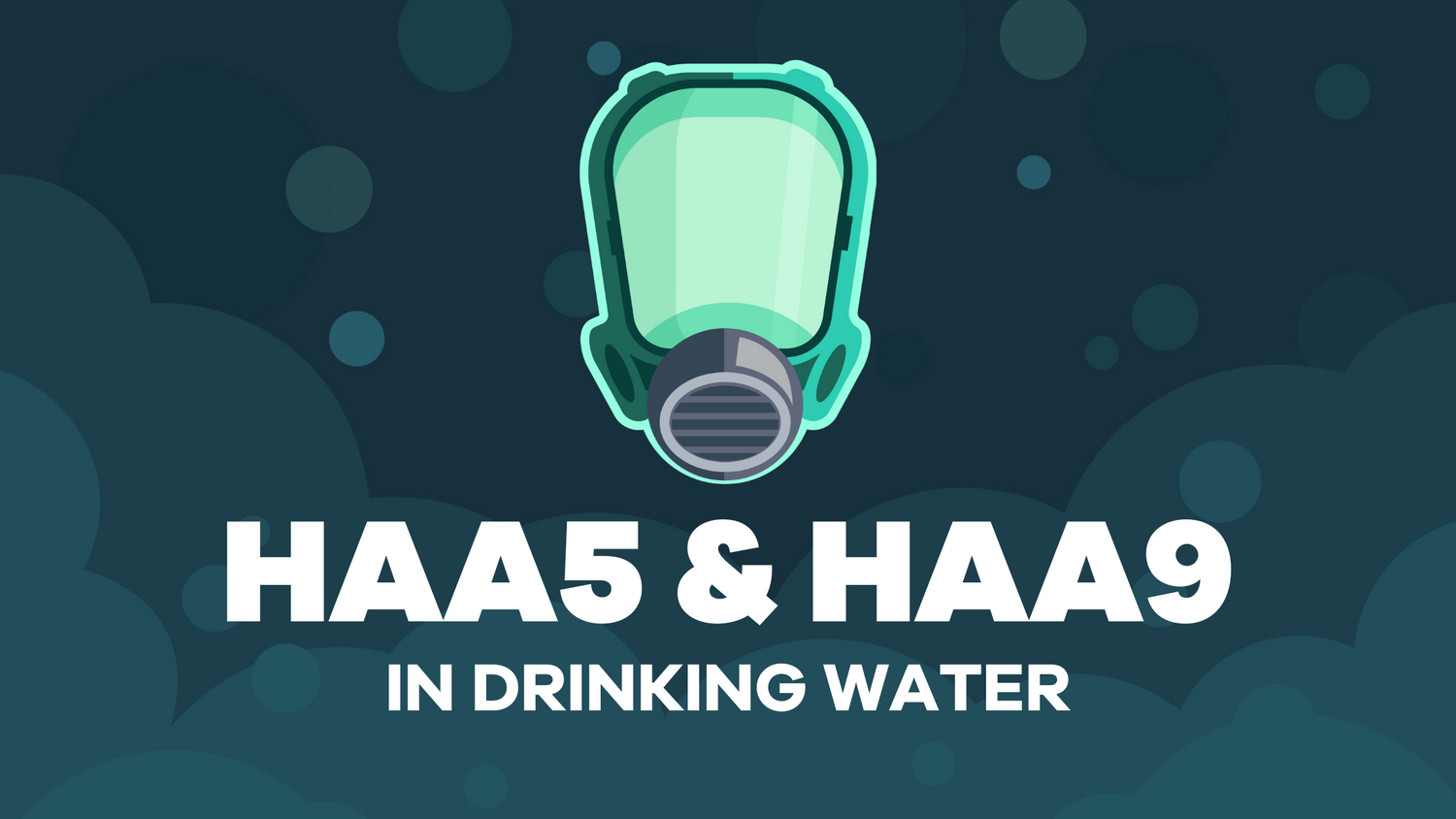
Quick Guide: Haloacetic Acids in Drinking Water Explained
Our blog is written by real experts— not AI. Each guide is carefully reviewed and updated based on the latest research. Plus, with no affiliate links, you can count on unbiased insights you can trust.
Haloacetic acids (including HAA5/HAA9) are one of the unintended byproducts formed during chlorine disinfection of drinking water. After testing your water to properly identify haloacetic acids (and their concentrations), you can consider installing the right filtration systems to help keep your drinking water safe.
Here's a helpful, affiliate-free filtration guide that can help you understand how and if you should filter your water for HAA5/HAA9.
What Are Haloacetic Acids (HAA5/HAA9)?
Haloacetic acids are a group of disinfection byproducts (DBPs) that are created when chlorine (and to a lesser extent, chloramine) reacts with naturally occurring organic matter found in water supplies during treatment. HAA5 is made up of the five haloacetic acid compounds that are regulated by the EPA:
- Dichloroacetic acid
- Trichloroacetic acid
- Monochloroacetic acid
- Monobromoacetic acid
- Dibromoacetic acid
Between 2018 and 2020, the EPA monitored public water systems for additional contaminants to update the Unregulated Contaminant Monitoring Rule (UCMR). Four additional haloacetic acids were included in monitoring for a total of nine (HAA9):
- Bromochloroacetic acid
- Bromodichloroacetic acid
- Dibromochloroacetic acid
- Tribromoacetic acid
While disinfection is important for controlling bacteria and other pathogens, long term exposure to haloacetic acids has been linked to harmful health effects.

Quick Guide: Understanding Chlorine and Chloramine in Drinking Water
Effects of Haloacetic Acids on the Body
The Environmental Protection Agency (EPA) states that drinking water containing total haloacetic acids (HAA5) above the regulatory limit (Maximum Contaminant Level, or MCL) of 0.06 PPM (parts per million) over many years may lead to health issues with the liver, kidneys, development, as well as an increased risk of cancer.[1]
HAA5 is only slightly absorbed through the skin and, unlike the other primary disinfection byproduct, trihalomethanes (THMs) (which are a group of volatile organic compounds, or VOCs), they do not vaporize into the air at bathing water temperature. Due to this, HAA5 is primarily a concern from water that is used for drinking and cooking.
In some human studies, exposure to DBPs, including HAA5, increased the incidence of bladder cancer. Based on animal data, the cancer risk for HAA5 is about 1 in 60,000 for every 10 years of consistent exposure at the current regulatory level.[2] Studies have also found that HAA5 exposure can lead to harmful effects on fetal growth and development during pregnancy.
Learn more about total trihalomethanes (TTHMS) in the Quick Guide to Trihalomethanes and HAA5/HAA9
How Do You Know Your Water Has HAA5?
Haloacetic acids cannot be seen, smelled, or tasted. However, chances are if you are a customer of a public water system (i.e., you get your water from a utility company), you have some DBPs in your water. Which DBPs are in your water will depend on the precise organic compounds in the source water, certain water chemistry parameters (e.g., pH, temperature), and the treatment plant’s methods.
Higher levels of these compounds are more likely to be found in water supplies sourced from surface waters—like rivers or reservoirs—than groundwater (e.g. aquifers) because of the increased presence of natural organic matter in lakes, rivers, and reservoirs.
Public water systems are required to notify their customers if haloacetic acids exceed the MCL of 0.06 PPM.
Having your water tested by a certified laboratory is the best way to learn the specifics about the HAA5/HAA9—and other DBPs—in your tap water.
How to Remove HAA5 from Your Drinking Water
If you’re concerned about the level of haloacetic acids in your drinking water, there are several options for filtering water at home.
Does Reverse Osmosis Remove Haloacetic Acids?
Yes, reverse osmosis water systems have been shown to reduce HAA5/HAA9. While RO systems are very effective at removing a wide array of contaminants, they are typically expensive to install and use large volumes of water.
Do Activated Carbon Filters Remove Haloacetic Acids?
Yes, activated carbon filters have been shown to be effective at reducing HAA5/HAA9 levels in tap water.
Do Filter Pitchers Remove Haloacetic Acids?
Depending on the type of technology the pitcher uses (such as those with activated carbon filters), point-of-use filters, like Brita or PUR, can reduce HAA5/HAA9 in water. But effectiveness may vary.
Do Ultraviolet (UV) Filters Remove Haloacetic Acids?
No, UV filters will not remove HAA5/HAA9. While UV filters may be used as an alternative to chlorine during central water treatment to avoid the creation of HAAs, it will not remove the haloacetic acids already in the water system.
Does Boiling Water Remove Haloacetic Acids?
No, boiling water will not reduce HAA5/HAA9. Boiling water can actually concentrate other contaminants in your water, and increases your risk of inhaling DBPs like trihalomethanes.
Additionally, there is no NSF/ANSI certification that specifically tests for HAAs, so we cannot recommend a certification that would guarantee the product was performance tested for that class of compounds.
The Top 5 Most Popular Water Filtration Technologies
What’s the Takeaway?
Ultimately, the safest approach to avoid HAA5/HAA9 is for utilities to prevent their formation during water treatment by deploying corrective approaches to remove natural organic matter from water supplies before disinfecting with chlorine, rather than filtering at home. But that’s far easier said than done.
- Haloacetic acids are a group of disinfection byproducts that are created when chlorine reacts with naturally occurring organic matter found in water supplies during treatment
- Five haloacetic acids (HAA5) are regulated by the EPA; the Maximum Contaminant Level for Total HAA5 is 0.06 PPM. Four additional haloacetic acid compounds were monitored under the UCMR (Unregulated Contaminant Monitoring Rule), for a total of nine (HAA9)—but they remain unregulated.
- After testing your water for haloacetic levels, you can consider a variety of treatment options for your water. Activated carbon filters have proven effective at reducing HAA5 levels in tap water.
Read More
▾Quick Guide to Trihalomethanes and HAA5/HAA9
Quick Guide to Chlorine and Chloramine in Drinking Water
Sources and References
▾- Haloacetic Acids - Maximum Contaminant Level Exceedances - Public Notification
- Late Pregnancy Exposures to Disinfection By-products and Growth-Related Birth Outcomes
- Drinking Water Treatment Units - Health Effects
- Want Clean Water? Turn on the Lights - Scientific American
- Oregon Department of Human Services HEALTH EFFECTS INFORMATION










